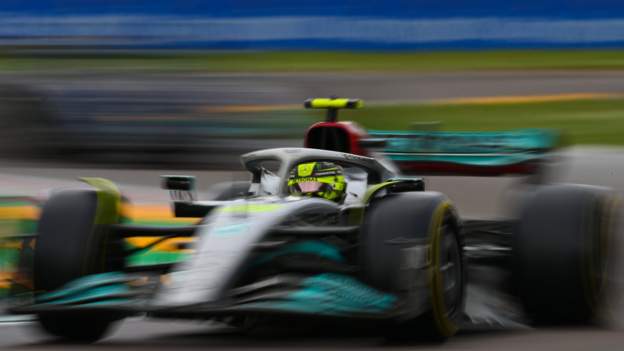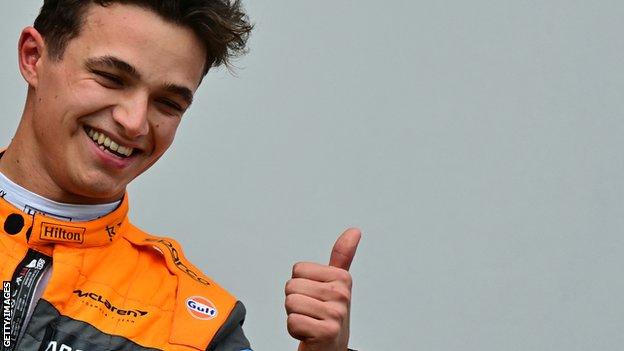
Have Formula 1’s new rules worked so far this year? McLaren driver Lando Norris certainly thinks so.
“It’s 100% better,” Norris said after finishing third in Sunday’s Emilia Romagna Grand Prix. “It’s what they intended to do and the reasons for the changes are working. I think you have been seeing better races this year than for many years.”
But hang on. Not so fast, Lando. Better racing was indeed the aim of the sweeping rule changes that were introduced this year – but commercial rights holder Formula 1 and governing body the FIA were specific about what they were trying to achieve.
The aim was to enable the cars to follow each other more closely, to close up the field from front to back so more teams were contesting for wins, and to allow the drivers to push much closer to flat-out for much more of the time.
As F1 managing director Ross Brawn put it before the start of the season: “I am confident these rules will lead to much better racing. I am convinced these cars will be closer in performance from the very beginning.
“I honestly don’t think the regulations will change the general order of things dramatically. I think it will bring it a lot closer and I think we will see some of what were the midfield teams challenging. We’ll have a bigger group of competitive teams.”
Has the sport succeeded? Let’s find out.
Can the cars follow more closely?
On this, the clear answer is yes, they can. The drivers are unanimous that it is possible to stay closer behind other cars for longer than before.
As world champion Max Verstappen puts it: “I do think that the cars are better to follow. At least you don’t have these weird moments anymore of like, big oversteer, big understeer.
“When you get within a second, it’s [still] hard to follow because of our cornering speed in a Formula 1 car. That will always be like that. But, yeah, I do feel it’s a bit nicer.”
Alpha Tauri’s Pierre Gasly adds: “I do feel it is an improvement compared to last year on all aspects. So I’m pretty happy so far with what we’ve seen. I do believe we can race closer to each other.
“It’s clearly a step in the right direction. I must say it has been more enjoyable, closer racing, more battles. I think the targets were matched.”
On this front, the wholesale change to the way the cars’ aerodynamics work, to ensure that a car following closely behind has its airflow less disrupted and can stay significantly closer to a car in front, has worked.
If you are viewing this page on the BBC News app please click here to vote.
Does that mean the racing is better?
This is a more subjective question, and the answer brings in a facet that remains controversial – the DRS overtaking aid.
There has certainly been a good amount of overtaking this year – the first two races, in particular, featured exciting battles for the lead between Verstappen’s Red Bull and Ferrari’s Charles Leclerc in which the two title contenders swapped places a number of times. This was undoubtedly a new development.
But the nature of these fights raised a question. Yes, the new cars allowed the drivers to get closer to each other more easily – but once there, was overtaking a bit too easy?
The DRS – which stands for Drag-Reduction System – is significantly more powerful with the new cars, which means it gives the car behind a bigger advantage than before.
The idea of a ‘DRS drive-by’ as a bad thing was already commonplace in F1 before this year. This is where the overtaking move is completed on the straight, because of the car behind’s speed advantage, rather than on the brakes into a corner.
This was very obvious in the Leclerc-Verstappen battle in Jeddah – to the extent that the two drivers were standing on the brakes before the braking zone into the final corner so as not to be ahead at the DRS detection line, to ensure they benefited from it on the following straight.
As Leclerc put it at the time: “We still need DRS but the one thing we might need to consider is the speed delta might be a bit too much.
“It gives the car behind too much of a speed delta that the overtaking is done before the braking. You’d much rather have the overtaking done during the braking rather than passing like in the highway, which is sometimes what can happen.”
When DRS was introduced in 2011, it was as a sticking-plaster solution to try to solve an inherent flaw in the cars – that it was difficult to stay close enough to follow. It was meant to make overtaking possible, not inevitable. And many people in F1 share the concern that at times this year the sport has been on the wrong side of that line.
Four-time champion Sebastian Vettel says: “The interesting bit would be to take the DRS off and see how the racing really is, if you are able to overtake a lot better than in the past.
“I’m only a bit cautious for the DRS, because it was brought in as an assistance to help overtaking but now it feels a bit like it’s the only thing that allows you to overtake at times. So, ideally, we have a set of regulations that allows us to follow and race without DRS.
“You know, DRS wasn’t there for 70 years. It was brought in 10 years ago to help, as an experiment. And I think an overtake should always be an effort and not dictated by you being in the zone and you get the DRS.
“The race in Jeddah, where you had the leaders braking for the DRS line to try and be the second one to cross that line, that’s a different type of racing. I don’t think we should go that way.
“We’re still early on the in the project. Definitely you can follow closer. Overtaking is still hard, but it should be an effort and it should be a reward when you manage to overtake.”
When the new rules were first conceived, back in 2019, the hope was that DRS would not be needed any more. But as work continued ahead of this year, F1 and the FIA came to believe that, right now, it is still required.
But there is an acceptance that the sport is in an experimental period, and that the DRS is something that could be changed or removed in the future.
The debate over whether it is needed, whether the balance is currently right, how the DRS could be operated differently and so on will continue.
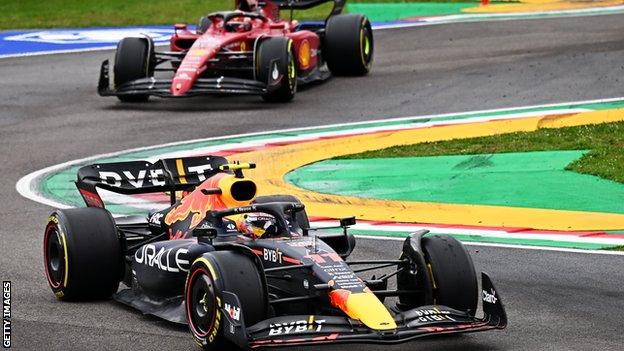
Is the field closer together?
On this front, the new rules have not been a success.
The 2021 title battle between Verstappen and Mercedes driver Lewis Hamilton was one of the greatest in history – but one of the complaints about last season was that only the two top teams had any realistic chance of competing for a win in a normal race. The rest of the teams were too far behind.
This year, it remains the case that two teams are closely matched at the front but out of reach of the rest – the only difference is that Ferrari have replaced Mercedes as Red Bull’s rivals.
Dig a little deeper into the statistics, and it’s clear that the rules have not succeeded in compacting the field – in fact, in some ways, it is even more spread out.
First, the two top teams. Over the whole of last year, there was just 0.067 seconds separating Mercedes and Red Bull on average qualifying pace. This year, excluding Imola from the calculation because of the vagaries of a wet session, the gap between Ferrari and Red Bull over one lap is 0.128secs on average.
The gap between the pace and the third fastest car? Over last year, there was 0.564secs on average between Mercedes and Ferrari in qualifying. So far this year, those two teams have swapped places, with Ferrari setting the pace and Mercedes third fastest on average – but the gap has gone out to 0.839secs.
In the races, Ferrari and Red Bull very quickly leave the rest behind and disappear into a fight of their own – just as Mercedes and Red Bull did last year.
The spread between the three fastest midfield teams? Last year, it was 0.084secs; this year it’s 0.303secs.
And the field spread from front to back? Almost exactly the same – 2.514secs in 2021; 2.510secs so far this year.
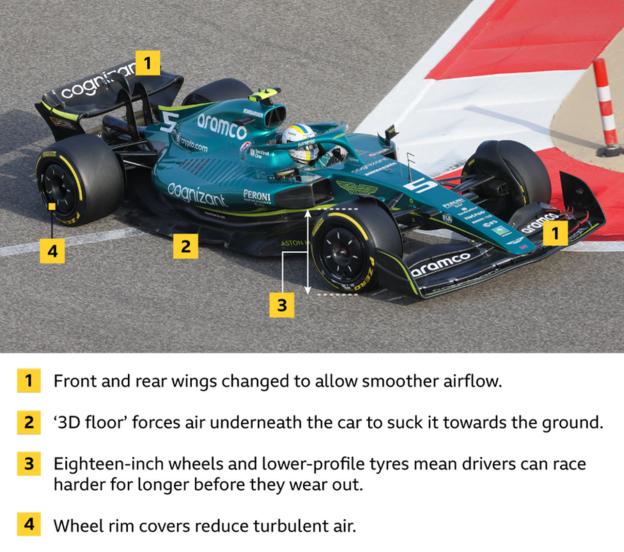
What about the tyres?
F1 has had a big change on the tyre front this year. Wheels have been increased from 13 inches to 18 inches in diameter, and new, lower-profile tyres have been designed to fit them. The aim was for these to be much more ‘raceable’ than before.
What this means is that the Pirellis have been known for being heat sensitive. Push hard on them – whether that means driving flat out or trying to overtake someone – and they overheat and lose grip.
This meant drivers deliberately lapping off the pace to keep the tyres within the required temperature threshold, and made overtaking even harder than it already was.
The idea was for this not to be the case this year. But while Pirelli F1 boss Mario Isola has expressed himself “quite happy with the performance of the tyres”, it seems there is still some work to do on this front.
Ferrari’s Carlos Sainz is among the drivers who has said he believes the tyres have made a step forward this season, but not all his colleagues agree it is an especially significant one.
Verstappen says: “The problem we have is the tyres – when we get close, you do burn your tyres a bit more than you would like and they overheat a bit more.
“We consistently work with Pirelli anyway, about what we would like and what we would like to improve. And it’s also very hard for them because it’s a completely new concept.
“We haven’t really done a lot of testing, so I’m sure now in the coming months or maybe for next year, we can improve things.”
Norris backs up Verstappen’s view that tyre overheating remains a limiting factor.
“The thing which doesn’t allow you to get even closer is the tyres,” he says. “I’m managing [them] pretty much every single lap in the race – even in qualifying, you have to manage a bit.
“So when you have these couple of oversteers when you’re following, when it gets a little bit harder, you pay the price very quickly and that’s what limits you to get that final bit to really overtake and maybe race as close as what you can in Formula 4 and things like that.
“Like Max said, Pirelli are working hard to improve this. It’s the first year on the tyre, they know what they need to work on and I’m sure they’ll come up with better tyres for next year.”
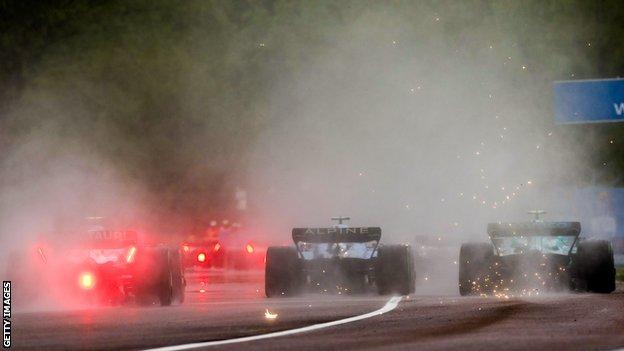
What does this all mean?
Since work started on the new rules, F1 and the FIA have always emphasised that the new rules were a starting point, not an end.
Four races into F1’s new era, after the biggest regulation change for 40 years, it is clear that the sport has made an important step forward in certain aspects of the racing, but that more work needs to be done to fulfil all the sport’s goals.
Equally, some things are not in an administrator’s control. Few would have predicted before the season, for example, that Mercedes would fall so dramatically from competitiveness.
It will take time for the full effect of the new rules to become clear – including the impact of the cost cap and other linked aspects of the new era, such as the sliding scale of development restrictions that allows the teams at the back to do more research and development than those at the front.
But for now, Brawn is positive.
“We have shown that the raceability of the car has to be a strong consideration going forward,” he says. “It is not just one solution and we are going to stop.
“We need to keep this process up and we need to keep working and understanding how we can make great racing cars and continue the development in that right direction.”


